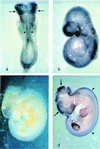Haploinsufficiency of Snf5 (integrase interactor 1) predisposes to malignant rhabdoid tumors in mice
- PMID: 11095756
- PMCID: PMC17655
- DOI: 10.1073/pnas.250492697
Haploinsufficiency of Snf5 (integrase interactor 1) predisposes to malignant rhabdoid tumors in mice
Abstract
Malignant rhabdoid tumor (MRT) is an aggressive, highly lethal cancer of young children. Tumors occur in various locations, including kidney, brain, and soft tissues. Despite intensive therapy, 80% of affected children die, often within 1 year of diagnosis. The majority of MRT samples and cell lines have sustained biallelic inactivating mutations of the hSNF5 (integrase interactor 1) gene, suggesting that hSNF5 may act as a tumor suppressor. We sought to examine the role of Snf5 in development and cancer in a murine model. Here we report that Snf5 is widely expressed during embryogenesis with focal areas of high-level expression in the mandibular portion of the first branchial arch and central nervous system. Homozygous knockout of Snf5 results in embryonic lethality by embryonic day 7, whereas heterozygous mice are born at the expected frequency and appear normal. However, beginning as early as 5 weeks of age, heterozygous mice develop tumors consistent with MRT. The majority of tumors arise in soft tissues derived from the first branchial arch. Our findings constitute persuasive genetic evidence that Snf5, a core member of the Swi/Snf chromatin-remodeling complex, functions as a tumor suppressor gene, and, moreover, Snf5 heterozygotes provide a murine model of this lethal pediatric cancer.
Figures





References
Publication types
MeSH terms
Substances
LinkOut - more resources
Full Text Sources
Molecular Biology Databases

